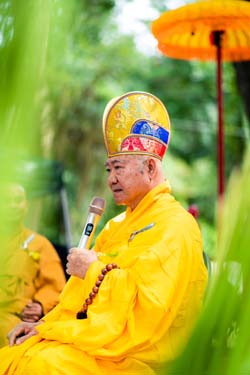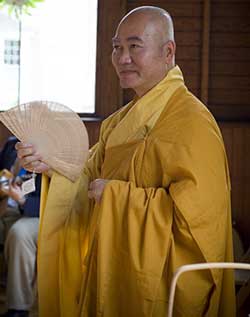 Guiding Teacher / Lineage
Guiding Teacher / Lineage
The Venerable Thich Tri Hoang, the founder of the Dharma Teacher Order, is the 9th generation in the Lieu Quán lineage, and he is the 43rd generation member of the Lâm Tế (Linji) lineage of Vietnamese Zen. The Venerable Thich Tri Hoang received his lamp transmission (Dharma transmission or end of formal study) in 1973 at the Hải Đức Temple in Nha Trang, Vietnam, from His Holiness Thich Giác Nhiên, Second Supreme Patriarch of the Unified Buddhist Church of Vietnam.
In 2000 the Venerable Thich Tri Hoang founded the Dharma Teacher Order at the Hai An Pagoda Buddhist Temple near Hartford, Connecticut. The decision to initiate the order came out of a desire to bring the benefit of Dharma practice and knowledge to the West. The guiding principles are quite simple:
- Deepen the members’ Dharma practice;
- Make the Dharma available to all interested persons;
- Provide a resource for teachers of Dharma;
- Train people to perform various ceremonial functions. The Vietnamese tradition of Buddhism is particularly suited to the modern world because of its emphasis on the “spirit” of Buddhism and its high tolerance for differences in interpreting the mundane aspects of the Dharma.

The origin of Chan (Chinese) – known as Thien in Vietnam, Seon in Korea, and Zen in Japan – is obscured by time; the tradition claims its origin from the Flower Sermon given by the historical Buddha. During the sermon the Buddha said nothing, just held up a flower – believed to be a lotus blossom. His disciple Mahākāśyapa, it is said, smiled at the flower. The Buddha made the following pronouncement upon seeing the smile: “I possess the true Dharma Eye, the marvelous mind of Nirvāṇa, the true form of the formless, the subtle Dharma gate that does not rest on words or letters but is a special transmission outside of the scriptures. This I entrust to Mahākāśyapa.“ The earliest record of this narrative dates to the 14th century CE.
Thus, Mahākāśyapa is considered to be the first principal teacher (Patriarch) of Zen after the Buddha himself. According to tradition he was followed by 26 Patriarchs in India before Bodhidharma is said to have traveled to China in the 5th century CE to introduce Chan (Zen) to China and become the founder and “ancestral” Patriarch of Chinese Chan. In all, there are six ancestral Patriarchs of Chan: 1) Bodhidharma (ca. 440–ca. 528); 2) Huike (487–593): 3) Sengcan (?–606); 4) Daoxin (580–651); 5) Hongren 601–674; 6) Huineng (638–713).
In the Tang dynasty Chan spread and Five Houses of Chan became established: Guiyang, Linji (Lâm Tế), Caodong, Yunmen, and Fayan schools. Virtually all Zen lineages trace their history through these five schools.
In Vietnam, Thien has a long history. Its first appearance is ascribed to 580 CE and a direct transmission from Sengcan, the third Patriarch of Chinese Chan, is claimed. Various other early schools developed, but in the 17th century, under the leadership of Nguyên Thiều, a new school, the Lâm Tế (Ling or Linji School) formed and flourished.
Like all things that are institutionalized, Chan in China waxed and waned, changing over time t from a nondogmatic approach that focused on experience and personal transmission from teacher to student, to a dogmatic institution that later, in at least one school in Japan, has been dismissively called “funeral Buddhism.” The historic migration of Chan (Zen) from one culture to another has served to revitalize its foundational principles and roots and helped to maintain the freshness of approach as it adapted to new realities. And so it happened in the migration from China to Vietnam, Chan acquired freshness by a syncratization of Thien with Pure Land, Theravada, and other elements in Vietnamese religious culture. With the migration of Thien to the West the school is, once again, revitalized, and now is being re-exported in a new form to Vietnam, where it is overcoming the challenges of current realities.
One of the clearest expressions of Thien was given by Thich Nhat Hanh in his book Vietnam:Lotus in a Sea of Fire (1967):
“In the history of Vietnamese Buddhism, Thien is by far the most important sect. The practice of Thien is by no means easy. It requires a profound and powerful inner life, long and persistent training, and a strong firm will. The attitude of Thien toward the search for truth and its view of the problem of living in this world are extremely liberal. Thien does not recognize any dogma or belief that would hold back man’s progress in acquiring knowledge or in his daily life. Thien differs from Orthodox religions in that it is not conditioned by any set of beliefs. In other words, Thien is an attitude or methodology for arriving at knowledge and action. For Thien the techniques of right eating and drinking, of right breathing and right concentration and meditation, are far more vital than mere beliefs. A person who practices Zen meditation does not have to rely on beliefs of hell, Nirvana, rebirth or causality; he has only to rely on the reality of his body, his psychology, biology, and his own past experiences of the instruction of Zen masters who have preceded him. His aim is to attain, to penetrate, to see. Once he has attained satori (insight) his action will conform by itself to reality.”
Following the heritage of Vietnamese Thien, which is highly tolerant of differences in practice and interpretation among its ordained members, the Dharma Teacher Order is nondenominational and transmits knowledge of the Theravada, Mahayana, and Varjayana traditions of Buddhism.
Click here for an interview that Thay had with Sondra Kaighen in 2020.
